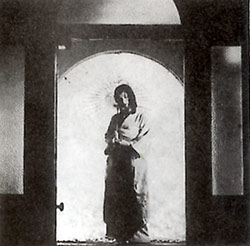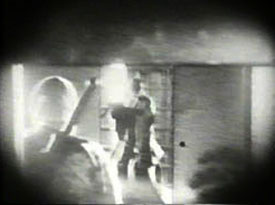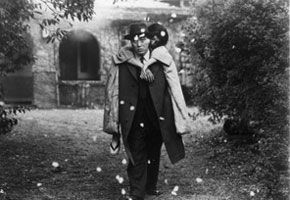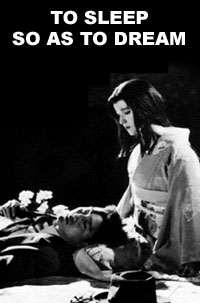 It's just the strangest thing that great movies can seemingly vanish from the face of the earth, even while movies bad beyond belief remain available on dvd.
It's just the strangest thing that great movies can seemingly vanish from the face of the earth, even while movies bad beyond belief remain available on dvd.
New Yorker Films distributed a little movie to film festivals in 1988, To Sleep So As to Dream (Yume Miruyoni Nemuritai, 1986), when I had the great good fortune to see it at the Seattle International Film Festival. For me it was the winner of the entire festival that year.
It appears to me that whoever saw this at film festivals at the time has never forgotten it, & it does turn up on a few film-fans' "ten best" lists of obscure favorites. Yet it never got a serious distribution contract, regarded as too arcane for western audiences, though in fact the Sherlockian ingredient & even the style of the film plugs into film history in the west just about as easily as does for Japanese film history.
A 35 mm print was again brought to Seattle in 2007 for a revival together with live musical accompanyment by the experimental jazz group Aono Jikken, & Ms. Naho Shioya emulating a benshi or silent film narrator, but mainly reciting translations the film's intertitle cards.
Aono Jikken's bandleader William Blauvelt had never been able to forget the film after its 1988 North American premier. He spent years trying to track down a copy. And after his coopting the visionary fantasy in his own work, it would afterward go back to the silent film preservation company Matsuda Films in Tokyo, so remains rarely to be seen by American audences.
I'm revamping my old review in order to frustrate Japan film fans who'll regret not being able to see this, though the real hope is that someone will be able to make noise in the right places to get a dvd release. Even with the first-time director's subsequent successes, this masterepiece has not been much singled out for attention.
 Set in a timeless postwar Japan of the 1950s, an aging actress whose heyday had been in the silent film era hires Detective Uotsuka (Shiro Sano) to find & save her kidnapped daughter Kikyo (Moe Kamura). It may well be that no such daughter exists, & the forgotten actress actually seeks to locate her own lost youth.
Set in a timeless postwar Japan of the 1950s, an aging actress whose heyday had been in the silent film era hires Detective Uotsuka (Shiro Sano) to find & save her kidnapped daughter Kikyo (Moe Kamura). It may well be that no such daughter exists, & the forgotten actress actually seeks to locate her own lost youth.
There is an element of Norma Desmond from Sunset Boulevard in Sakura (Fujiko Fukamizu), the old woman who incessantly watches her last silent film with the missing reel, & who seeks an imaginary woman who embodies her own past. But while Norma is dangerously insane, Sakura is more like a hidden doorway to paradise, a fairy creature not so much mad as she is not wholly of this world.
She watches the antique, faded, scratched, flairing samurai film endlessly, forever hoping to reach the end, but the tale invariably breaks off at the point where the masked hero is about to reveal himself.
Sakura doesn't know how the story ends, nor who the mysterious hero was, having either forgotten due to senility or because the story truly never completed filming.
Filmed in black & white, & very remiscent of the look & pacing of Japanese silent movies, the visual excellence of To Sleep So As To Dream cannot be exaggerated. It's stunning to gaze upon, & every moment of the film is an adoring tribute to the silent films.
Just as the old woman's "daughter" is symbolic of her lost youth, for the detective (who is as obviously symbolic of director-writer Kaizo Hayashi), the missing "daughter" is his Beloved, who is in part the silent films themselves.
 Detective Uozuka has in essence fallen in love with a young woman who no longer exists, who is now an old woman. He watches her in her great silent roles, & he has an aching nostalgic for that lost world, & for the woman on the screen. Detective Uozuka has in essence fallen in love with a young woman who no longer exists, who is now an old woman. He watches her in her great silent roles, & he has an aching nostalgic for that lost world, & for the woman on the screen.
What might've been the greatest of her roles -- & what might've kept her name alive into the present day -- was a never-released film with a final reel never seen, perhaps never filmed. Or, if it were filmed, was soon lost. It was a samurai film called The Eternal Mystery & the missing reel comes to obsess the young detective, who emotionally confuses the allegedly kidnapped "daughter" with that silent movie's missing reel.
Firebombing of Tokyo took out most of Japan's silent film heritage & the whole idea of "the lost reel" has echoes of historical loss for any devoted film fan. The fantasy of this film is that the essence such things are not necessarily permanently lost. The unfinished film, or the missing reel, can be recovered, or recreated, by longing for it, living it, becoming it.
The sense of reality between the dreamily silent To Sleep So As To Dream & the imagined The Eternal Mystery begins to break down, so that our detective by the end no longer distinguishes between himself as a character in one film, & as observer of another film within the film. As the two become one, a fairy-tale comes true, the "daughter" of lost youth & the longed-for beloved are capable of unity at last.
Often whimsical & absurd -- the detective's inept sidekick Kobayashi (Koji Otake) is in essence an embodiment of slapstick commedians fo the silent era -- & always poetic with a mystical edginess, this is the finest homage to silent films that has ever been committed to celluloid. It causes to viewer to ache for just such magic as snares Uozuka.
Along the way it manages to embody a real history of Japan's very unique silent cinema, its benshi narrators (with authentic benshi Shunsui Matsuda playing just such a narrator), & the benshi predicessors of "the paper theater" (kami shibai) of just such storytellers using postcard images instead of film footage.
Silent film fans will find this movie especially awesome but everyone who loves good storytelling, a good romance, a good fairy tale, will find themselves totally absorbed by To Sleep So As To Dream, & become nostalgic for a world never known.
copyright © by Paghat the Ratgirl
|

